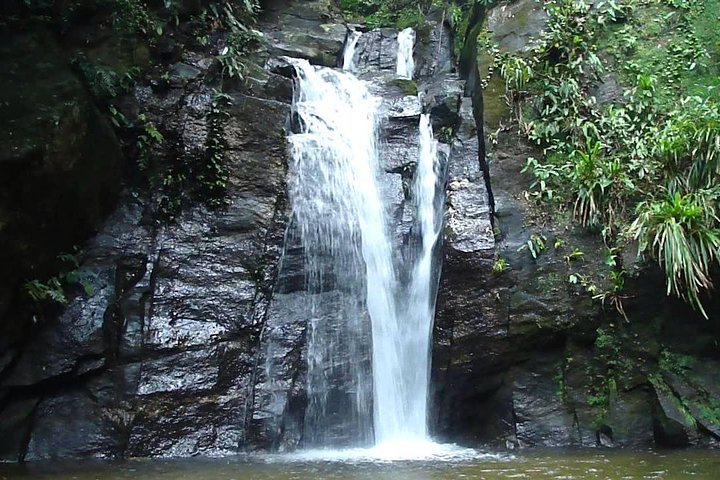Under the Canopy: Chasing Horto’s Waterfalls in Tijuca National Park
A four-hour urban-forest hike and swim loop through one of the world’s largest city parks
You step off the van and the city’s honk fades like a curtain dropping. A cool, green hush takes its place—ferns brushing your calves, bromeliads cupping rain like small green bowls, and the air tasting faintly of loam and salt carried from the coast. The Horto Waterfalls Circuit begins with the sound you came for: water, patient and constant, threading through rock and root. Over four hours you’ll move through that rhythm—climbing narrow trails, crossing wooden footbridges, and slipping into natural pools beneath fern-fringed cascades. The forest here is not shy. It nudges you forward, offers cold showers under a thin drop of water, then widens to a viewpoint where Rio’s granite shoulders puncture the skyline.
Trail Wisdom
Start Early on Weekends
Begin before 9 AM to avoid crowds and secure the best swimming spots.
Wear Grippy Shoes
Slick rock and root fields make a sturdy trail shoe or low hiker essential for safety.
Bring a Dry Bag
Protect phone, snacks, and spare layers from sprays and unexpected showers.
Swim Cautiously
Waterfalls permit bathing, but follow your guide’s advice—hidden currents and submerged rocks exist.
Local Knowledge
Hidden Gems
- •Small natural plunge pools below Box Waterfall—less visited late afternoon
- •A viewpoint alcove halfway through the circuit with a framed view of Rio’s western ridges
Wildlife
Toucans (occasionally), Capuchin monkeys
Conservation Note
Tijuca is a managed national park—stay on marked trails, avoid using soaps in pools, and pack out all waste to protect sensitive Atlantic Forest habitats.
The Tijuca Forest was largely replanted in the 19th century to restore water supplies and counter deforestation tied to early coffee cultivation.
Seasonal Guide
spring
Best for: Wildflowers and new leaves, Fewer crowds than summer
Challenges: Occasional afternoon showers, Trail muddiness after rains
Spring brings fresh green growth and comfortable temperatures, though brief showers can make trails slick—pack a light rain layer.
summer
Best for: Warm water swims, Lush canopy
Challenges: Higher humidity and heat, More weekend visitors
Summer is ideal for cooling dips but expect hot, humid conditions and busy mornings at popular falls.
fall
Best for: Clearer skies and views, Comfortable hiking temperatures
Challenges: Unpredictable rain events, Shorter daylight hours
Fall often offers crisp mornings and pleasant hiking; late rains can still make footing tricky, so wear proper shoes.
winter
Best for: Drier trails and easier views, Cooler forest air
Challenges: Cooler water temperatures for bathing, Less daylight late in the day
Rio’s winter brings drier weather and clearer trails, making it a dependable season for the Horto circuit—water will be cooler but refreshing.
Photographer's Notes
What to Bring
Sturdy Trail ShoesEssential
Grip and ankle support help on wet rock and exposed roots.
Hydration Bladder or 1–2L Water BottleEssential
Sustained energy and focus depend on adequate hydration in humid forest conditions.
Quick-Dry Swimwear and Microfiber TowelEssential
Allows you to take advantage of the permitted bathing spots without staying wet for the rest of the hike.
Light Waterproof Shell
Protects against sudden showers and preserves core warmth on cool mornings.
Common Questions
How long is the Horto Waterfalls Circuit?
The guided tour runs about 3–4 hours and typically covers roughly 6 kilometers with multiple waterfall stops.
Is swimming allowed at all the waterfalls?
Yes—this circuit permits bathing at its waterfall pools, but follow your guide’s instructions for safe entry points and current conditions.
Do I need to be an experienced hiker?
No—fitness at a moderate hiking level is sufficient. The route has some steep sections and slick rock but requires no technical climbing skills.
How do I get to the trailhead from central Rio?
Many tours include pickup; if going independently, allow 30–60 minutes by car from central neighborhoods depending on traffic and use the Alto da Boa Vista/Horto area as your destination.
Are there restroom facilities along the hike?
Facilities are limited in the forest; use restrooms at trail access points before you start and carry hand sanitizer for mid-hike needs.
Is the hike suitable for kids?
Yes—families often do the circuit, but supervise children at pools and on exposed rock; choose a slower pace and confirm any age limits with tour operators.
What to Pack
Trail shoes, swimwear, 1–2 liters of water, small dry bag to protect electronics
Did You Know
Tijuca National Park is one of the largest urban forests in the world and was largely replanted in the 19th century to restore the watershed for Rio de Janeiro.
Quick Travel Tips
Book morning slots to avoid crowds; bring cash for quick purchases; download an offline map before entering the canopy; confirm pickup location with your operator
Local Flavor
After the hike, head to Alto da Boa Vista or nearby Santa Teresa for a late lunch—look for simple churrascarias, tapioca stands, or a bar serving cachaça and cold beer to refuel with Carioca flavors.
Logistics Snapshot
Closest airports: Santos Dumont (SDU) or Galeão (GIG); Trailhead driving time: 30–60 minutes from central Rio depending on traffic; Cell service: intermittent under canopy; Permits: no special permits—guided tours recommended for logistics and safety.
Sustainability Note
This circuit runs through protected Atlantic Forest—stay on established trails, carry out trash, and avoid introducing soaps or sunscreens into natural pools.

